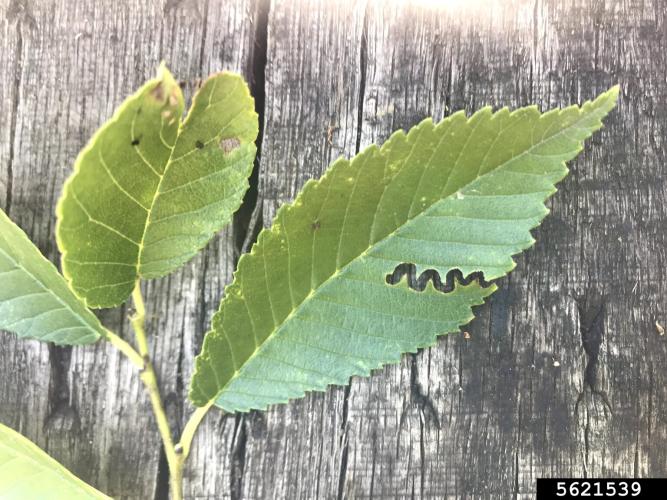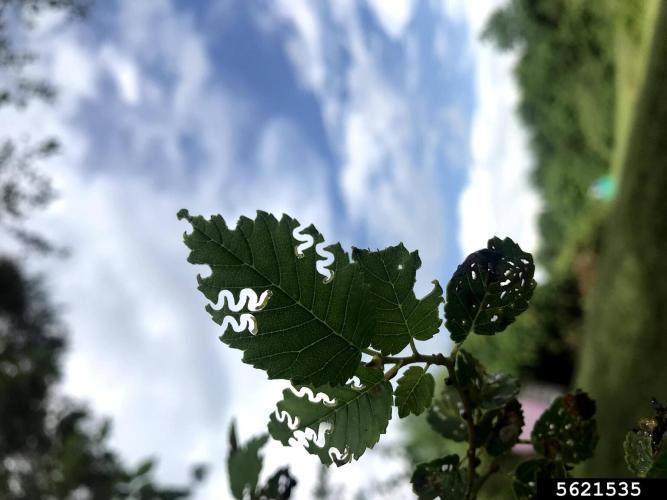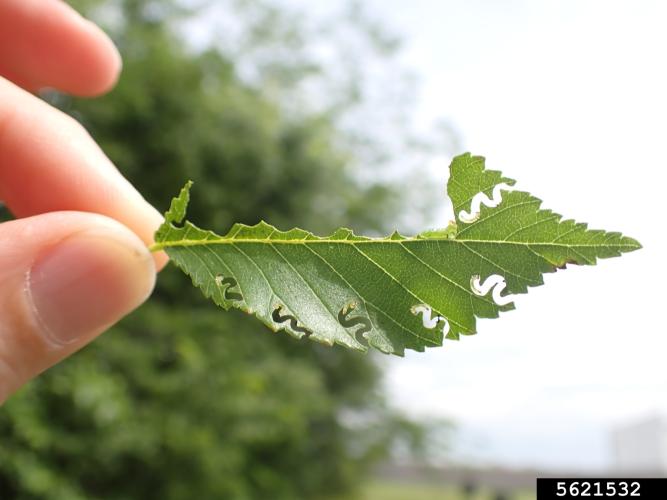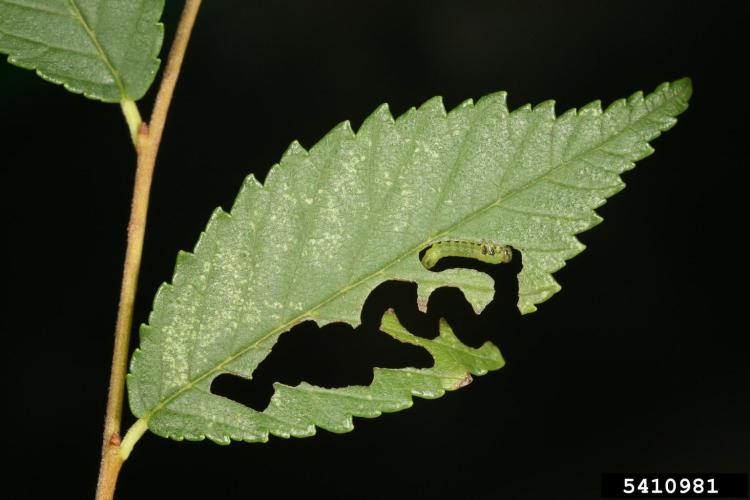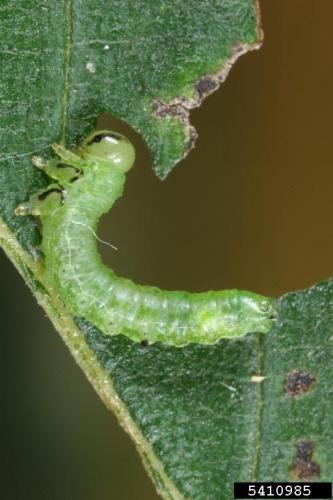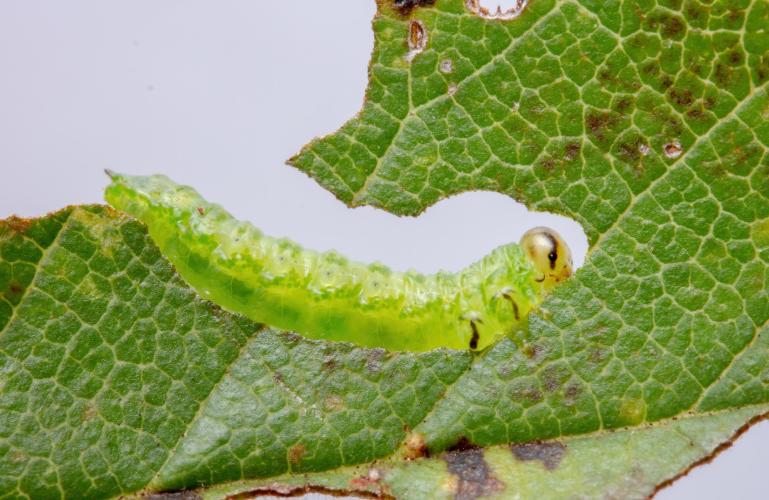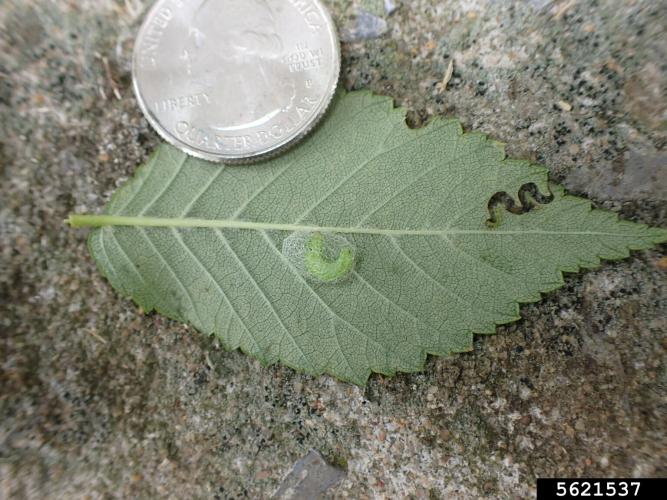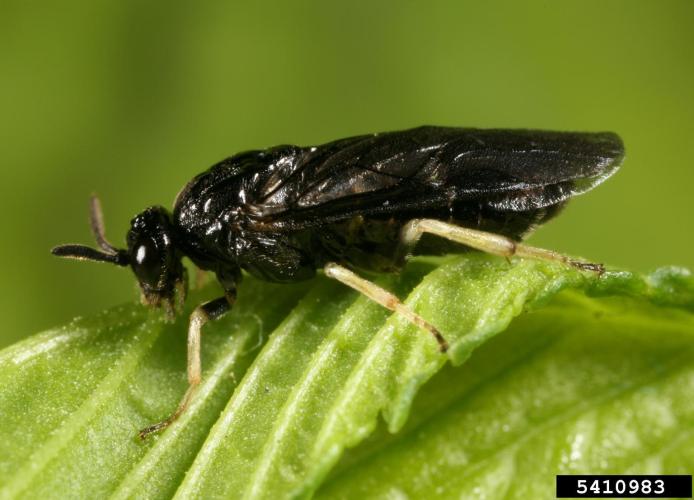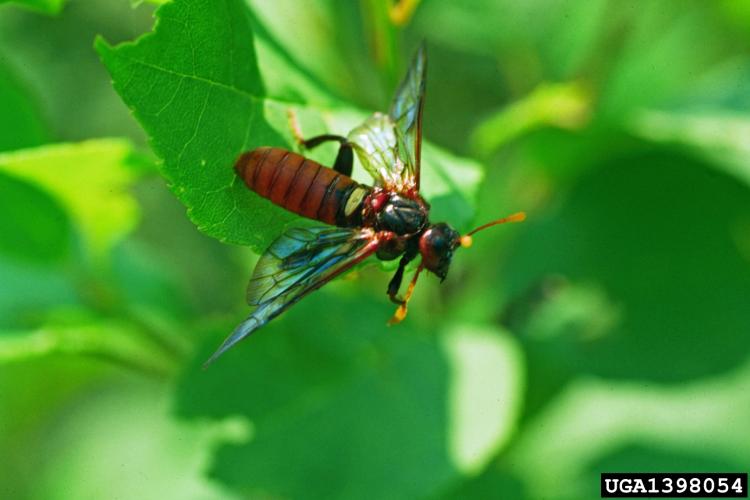Elm Zigzag Sawfly
Identification
Elm zigzag sawfly (EZS), once hatched, has three life stages: larva, pupa and adult fly.
Larvae are very small, 1.8 mm long and a grayish-white color after first emerging from the egg. Mature larvae are green with a black band on their head and T-shaped brown or black markings above the second and third pair of true legs. They can grow up to 10-11 mm long.
The lattice-like, silken cocoons are attached to undersides of leaves, branches, or shoots. In summer, the cocoon is loosely woven and light; overwintering cocoons are dense and found in the decomposing organic material layer (duff) on the ground. During the winter months, the dormant pupae often go unnoticed, buried just beneath the duff and leaf litter. Although an isolated pupa would be difficult, if not almost impossible, to identify as an elm zigzag sawfly pupa. A pupa within a lattice-like cocoon on the underside of an elm leaf is likely EZS.
Adult elm zigzag sawfly are small, shiny black, winged insects, reaching 7-8 mm long. There is a white patch on the underside of the thorax and a dark brown “upper lip". They have yellow to white legs with white tips and smoky-brown wings.
SIGNS AND SYMPTOMS
The signature ‘zigzag’ pattern is key to identifying this species in the early stages of the larval form. Larvae can be found during the months of May through October, and though EZS are small insects, outbreaks can defoliate large elm trees. Elm zigzag sawfly can go unnoticed for a long period of time after introduction because early infestations are often difficult to detect as defoliation is less noticeable in low densities.
Young elm zigzag sawfly larvae create a characteristic (and namesake) zigzag pattern in leaves, while older larvae feed more broadly on leaf tissue, leaving behind only thick leaf veins and often eliminating the zigzag-shaped damage.
Generally, defoliated trees can recover from a defoliation event. However, if trees are heavily defoliated year after year, they may become weakened or stressed, which predisposes them to other pests or results in tree death.
Biology
Origin
Elm zigzag sawfly is native to East Asia, including Japan, eastern Russia, eastern China, and the Korean peninsula. It was first detected in Europe, where it is considered invasive, in 2003. It was first detected in North America in Québec, Canada in 2020 and has since been found in numerous states in the US including Virginia (2021) and North Carolina, Maryland, Pennsylvania, and New York in 2022.
Host Species
In Europe, the insect attacks almost all elm species (Ulmus sp.), both native and exotic, including elm cultivars resistant to Dutch elm disease. During the first year of its discovery in Canada (2020), it was found mainly on American elm (Ulmus americana), but all elm species planted in North America should be considered as potential hosts.
Life Cycle
Adults reproduce parthenogenetically, meaning females reproduce without mating. No male elm zigzag sawflies have been observed.
Females lay up to 60 eggs singly along the tips of elm leaf serrations. Within eight days, larvae emerge and begin feeding. Elm zigzag sawfly larvae have six instars and pupate within three weeks of emerging from the egg. Two types of cocoons may be formed: either a loosely-spun, net-like cocoon attached to leaves (created during summer months) or a solid-walled cocoon in leaf litter or soil (overwintering generation).
In North Carolina, where heavy defoliation was observed in mid-August (2022), the net-like cocoons were attached to other objects (e.g., fence posts) in the absence of leaves, which had been consumed. Adults emerge within 10 days of cocoon creation. Research in Europe, upon which these life stage estimates are based, indicates a full generation can occur in less than a month (24-29 days).
Multiple generations of elm zigzag sawfly can occur per year, but the number varies. For example, in Virginia, two generations were observed in 2021 and one generation in 2022. Lab-reared elm zigzag sawfly have up to seven generations per year, but field observations in Europe and Russia indicate up to four generations occur per year.
Ecological Threat
Elm zigzag sawfly is a proven highly competitive elm specialist which could impact native elm browsers. North America is home to its own native elm feeding insects which could be outcompeted by elm zigzag sawfly. Significant branch die-back caused by the pest can contribute to weakened overall tree health, and potentially tree mortality. This has potential to further exacerbate the decline of elm trees in conjunction with other pressures including Dutch elm disease (Ophiostoma ulmi).
Vermont Distribution
Citations
Elm Zigzag Sawfly, Invasive Species Centre
Elm Zigzag Sawfly, NC State Extension Publications
Elm zigzag sawfly (nrcan.gc.ca)
Photo Credits
Eric R. Day, Virginia Polytechnic Institute and State University, Bugwood.org
Gyorgy Csoka, Hungary Forest Research Institute, Bugwood.org
Steven Katovich, Bugwood.org
